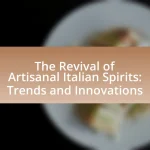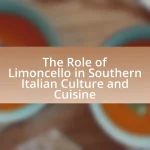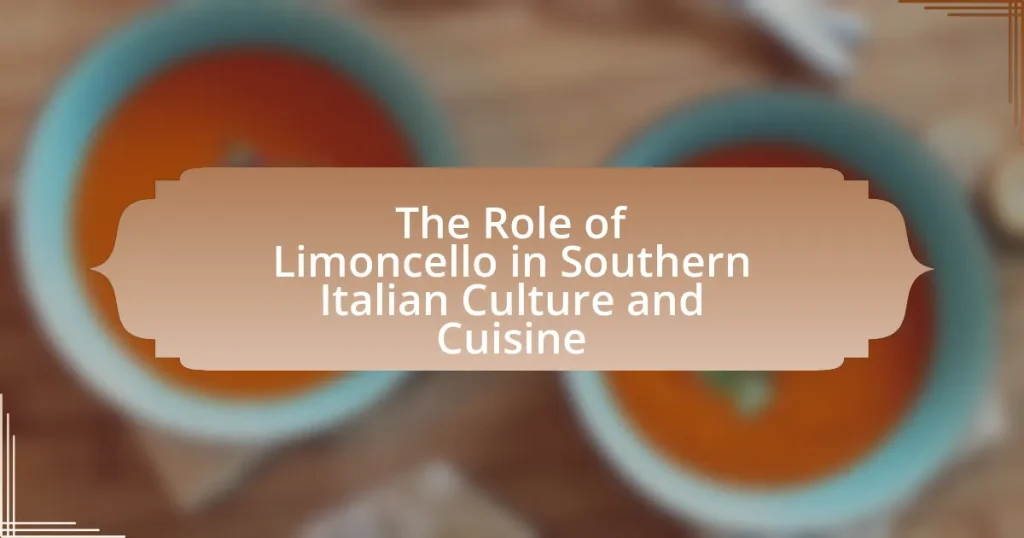Limoncello is a traditional Italian lemon liqueur with deep cultural significance in Southern Italy, particularly in regions like Campania and Sicily. The article explores its historical roots, production methods, and essential ingredients, highlighting how Limoncello reflects the agricultural heritage and social customs of the region. It also examines its role as a digestif, its integration into local cuisine, and its presence in modern adaptations and global influence. Additionally, the article discusses the evolving trends in Limoncello consumption and its impact on international cuisine, showcasing its versatility in both traditional and contemporary contexts.

What is Limoncello and its Historical Significance in Southern Italy?
Limoncello is a traditional Italian lemon liqueur primarily produced in Southern Italy, particularly in regions like Campania and Sicily. This liqueur is made by infusing lemon zest from Sorrento lemons in alcohol, resulting in a sweet, tangy beverage often served chilled as a digestif. Historically, Limoncello has significant cultural roots in Southern Italy, where it is believed to have originated in the early 20th century, although some sources suggest its existence dates back to the 19th century. The liqueur is deeply intertwined with local customs and hospitality, often enjoyed after meals to aid digestion and celebrate social gatherings. Its production is a reflection of the region’s agricultural heritage, utilizing locally sourced lemons, which are a vital part of the Southern Italian landscape and economy.
How is Limoncello traditionally made?
Limoncello is traditionally made by infusing lemon zest in high-proof alcohol, typically grain alcohol or vodka. The process begins with the careful peeling of fresh, organic lemons to extract the essential oils from the zest, avoiding the bitter white pith. The lemon peels are then steeped in the alcohol for a period ranging from a few days to several weeks, allowing the flavors to meld. After the infusion, a simple syrup made from sugar and water is added to the mixture, balancing the tartness of the lemons with sweetness. Finally, the Limoncello is filtered and bottled, resulting in a vibrant, aromatic liqueur that is often served chilled. This traditional method has been passed down through generations in Southern Italy, particularly in regions like Campania and the Amalfi Coast, where lemons are abundant.
What ingredients are essential for crafting authentic Limoncello?
The essential ingredients for crafting authentic Limoncello are lemons, alcohol, sugar, and water. Specifically, high-quality, organic lemons, preferably from the Sorrento region of Italy, are used for their aromatic zest. The alcohol typically used is a neutral spirit, such as grain alcohol or vodka, which extracts the lemon oils effectively. Sugar is added to create a balanced sweetness, and water is used to dilute the mixture to the desired strength. These ingredients are crucial for achieving the traditional flavor profile and authenticity of Limoncello, which is deeply rooted in Southern Italian culture and cuisine.
What are the steps involved in the Limoncello production process?
The steps involved in the Limoncello production process include selecting high-quality lemons, typically Sorrento lemons, followed by washing and peeling the lemons to extract the zest. The next step is to steep the lemon peels in high-proof alcohol for a period, usually around one to two weeks, allowing the flavors to infuse. After steeping, the mixture is strained to remove the peels, and a simple syrup made from water and sugar is added to achieve the desired sweetness and alcohol content. Finally, the Limoncello is bottled and allowed to rest for a few days before consumption. This process is rooted in tradition, particularly in Southern Italy, where Limoncello is a staple after meals.
Why is Limoncello considered a cultural symbol in Southern Italy?
Limoncello is considered a cultural symbol in Southern Italy due to its deep-rooted association with the region’s traditions, cuisine, and social practices. This lemon liqueur, primarily produced in areas like the Amalfi Coast and Sorrento, embodies the local agricultural heritage, particularly the cultivation of the Sorrento lemon, which is a key ingredient. The production of Limoncello is often a family tradition, passed down through generations, reflecting the communal and familial values prevalent in Southern Italian culture. Additionally, Limoncello is commonly served as a digestif after meals, reinforcing its role in social gatherings and celebrations, thus solidifying its status as a cultural emblem of hospitality and conviviality in the region.
How does Limoncello reflect the traditions of Southern Italian families?
Limoncello reflects the traditions of Southern Italian families by serving as a symbol of hospitality and celebration. This traditional lemon liqueur is often homemade, with families passing down recipes through generations, emphasizing the importance of family bonds and shared experiences. The production of Limoncello typically involves local lemons, particularly the Sorrento variety, which highlights the region’s agricultural heritage and connection to the land. Additionally, Limoncello is commonly served at the end of meals during family gatherings, reinforcing its role in fostering togetherness and cultural identity within Southern Italian communities.
What role does Limoncello play in local festivals and celebrations?
Limoncello serves as a traditional celebratory drink in local festivals and celebrations in Southern Italy. It is often enjoyed as a digestif after meals, symbolizing hospitality and community spirit. During events such as weddings, religious festivals, and local fairs, Limoncello is frequently offered to guests, reinforcing cultural ties and enhancing the festive atmosphere. Its production is also celebrated, with festivals dedicated to the lemon harvest, showcasing the importance of this liqueur in regional identity and culinary heritage.

How is Limoncello integrated into Southern Italian Cuisine?
Limoncello is integrated into Southern Italian cuisine primarily as a digestif, traditionally served after meals to aid digestion. This practice is rooted in the region’s culinary customs, where Limoncello is often enjoyed chilled in small glasses, enhancing the dining experience with its refreshing citrus flavor. Additionally, Limoncello is used in various desserts and cocktails, showcasing its versatility in both sweet and savory dishes. The drink’s origins trace back to the Amalfi Coast, where local lemons are harvested, further solidifying its cultural significance in Southern Italy.
What are the common ways Limoncello is served in meals?
Limoncello is commonly served as a digestif after meals in Southern Italian cuisine. This traditional practice is rooted in the belief that the citrus liqueur aids digestion, making it a popular choice to conclude a meal. Additionally, Limoncello can be used as a flavoring in desserts, such as drizzling over cakes or incorporating into sorbets, enhancing the overall dining experience with its bright, zesty flavor. The serving of Limoncello chilled in small glasses is a customary practice, often accompanied by coffee or fruit, further emphasizing its role in the culinary traditions of Southern Italy.
How does Limoncello complement traditional Southern Italian dishes?
Limoncello complements traditional Southern Italian dishes by enhancing their flavors and providing a refreshing contrast to rich and savory elements. The bright, citrusy notes of Limoncello balance the heaviness of dishes like pasta with creamy sauces or fried seafood, making the overall dining experience more enjoyable. Additionally, Limoncello is often served as a digestif, aiding digestion after a meal, which is a common practice in Southern Italy. This cultural pairing is rooted in the region’s culinary traditions, where the use of local lemons in Limoncello reflects the agricultural heritage and enhances the authenticity of the dining experience.
What are popular recipes that incorporate Limoncello?
Popular recipes that incorporate Limoncello include Limoncello cake, Limoncello tiramisu, and Limoncello sorbet. Limoncello cake is a moist dessert that uses Limoncello in the batter and glaze, enhancing its citrus flavor. Limoncello tiramisu adds a refreshing twist to the classic Italian dessert by replacing coffee with Limoncello, creating a unique flavor profile. Limoncello sorbet is a frozen treat that showcases the liqueur’s bright lemon taste, often served as a palate cleanser. These recipes highlight Limoncello’s versatility in enhancing both sweet and refreshing dishes in Southern Italian cuisine.
Why is Limoncello often enjoyed as a digestif?
Limoncello is often enjoyed as a digestif because its high alcohol content and citrus flavor aid in digestion. Traditionally served chilled after meals, Limoncello is believed to stimulate the digestive system, making it a popular choice in Southern Italian culture. The drink’s lemon essence is thought to enhance the digestive process, aligning with the customs of enjoying herbal or citrus-based liqueurs post-meal to promote comfort and digestion.
What are the health benefits associated with consuming Limoncello after meals?
Consuming Limoncello after meals may aid digestion and enhance the overall dining experience. The high alcohol content in Limoncello can stimulate the production of gastric juices, which facilitates the digestive process. Additionally, the lemon flavor provides a refreshing palate cleanser, potentially reducing feelings of fullness and discomfort after a heavy meal. Studies have shown that citrus fruits, like lemons, contain compounds that may support digestive health, further validating the benefits of consuming Limoncello post-meal.
How does the alcohol content of Limoncello affect its role as a digestif?
The alcohol content of Limoncello, typically ranging from 25% to 30% ABV, enhances its effectiveness as a digestif by stimulating digestion and providing a warming sensation after meals. This higher alcohol concentration promotes the release of gastric juices, which aids in the digestive process, making it a traditional choice in Southern Italian culture for post-meal consumption. Studies indicate that alcoholic beverages with moderate alcohol content can facilitate digestion, aligning with Limoncello’s role in culinary practices where it is served to conclude meals.

What are the modern adaptations and global influence of Limoncello?
Modern adaptations of Limoncello include variations such as Limoncello cream, which combines traditional lemon liqueur with cream for a richer flavor, and fruit-infused versions that incorporate other citrus fruits or herbs. The global influence of Limoncello is evident in its widespread popularity beyond Italy, with bars and restaurants worldwide offering it as a digestif or cocktail ingredient, contributing to the rise of Italian-inspired cocktails. The drink’s appeal has led to the establishment of Limoncello production in countries like the United States and Australia, where local producers create their own interpretations, further enhancing its international presence.
How has Limoncello evolved in contemporary Southern Italian culture?
Limoncello has evolved into a symbol of Southern Italian culture, reflecting both tradition and modernity. Originally a homemade digestif, Limoncello is now commercially produced and widely recognized, contributing to the region’s tourism and culinary identity. The rise of artisanal brands and the incorporation of Limoncello into contemporary cocktails demonstrate its adaptation to modern tastes while maintaining its cultural roots. Additionally, festivals celebrating Limoncello have emerged, further embedding it in the social fabric of Southern Italy, showcasing its significance beyond mere consumption to a representation of local heritage and pride.
What new flavors and variations of Limoncello are emerging?
Emerging flavors and variations of Limoncello include innovative infusions such as strawberry, raspberry, and even herbal blends like basil and rosemary. These new interpretations reflect a trend towards experimentation in traditional Italian liqueurs, appealing to modern palates. For instance, the introduction of fruit-based Limoncello variations has gained popularity in artisanal distilleries, showcasing local produce and enhancing the traditional lemon base. Additionally, some producers are incorporating spices and botanicals, which diversifies the flavor profile and aligns with the growing consumer interest in craft spirits.
How do modern production methods differ from traditional ones?
Modern production methods for limoncello differ from traditional ones primarily in their use of technology and efficiency. Traditional methods often involve manual processes, such as hand-peeling lemons and infusing them in alcohol over extended periods, typically weeks to months. In contrast, modern methods utilize advanced machinery for peeling, extraction, and infusion, significantly reducing production time to days. Additionally, modern techniques may incorporate precise temperature control and automated bottling processes, enhancing consistency and scalability. These advancements allow producers to meet higher demand while maintaining quality, as evidenced by the increased production capacity seen in commercial limoncello brands compared to artisanal producers.
What impact has Limoncello had on international cuisine?
Limoncello has significantly influenced international cuisine by popularizing the use of citrus-based liqueurs in culinary applications. This Italian lemon liqueur, traditionally served as a digestif, has inspired chefs worldwide to incorporate its bright, zesty flavor into various dishes, desserts, and cocktails. For instance, Limoncello has been used in recipes for sorbets, cakes, and marinades, enhancing the flavor profiles of both sweet and savory dishes. Its rise in popularity is evidenced by the increasing number of restaurants and bars globally that feature Limoncello-infused cocktails, showcasing its versatility and appeal beyond Italian cuisine.
How is Limoncello being used in cocktails around the world?
Limoncello is being used in cocktails around the world primarily as a vibrant, citrusy liqueur that enhances flavor profiles and adds a refreshing twist to various drinks. In Italy, it is commonly mixed into spritzers, such as the Limoncello Spritz, which combines Limoncello with prosecco and soda water, creating a light and effervescent beverage. Internationally, bartenders incorporate Limoncello into cocktails like the Limoncello Martini, blending it with vodka and lemon juice for a zesty alternative to traditional martinis. Additionally, Limoncello is featured in tropical cocktails, where its sweetness complements rum and fruit juices, making it a versatile ingredient in mixology. The global popularity of Limoncello in cocktails reflects its ability to elevate drinks with its unique flavor, making it a staple in bars and restaurants worldwide.
What are the trends in Limoncello consumption outside of Italy?
Limoncello consumption outside of Italy is experiencing significant growth, particularly in the United States and other European countries. This increase is driven by the rising popularity of Italian cuisine and the growing interest in artisanal and craft spirits. For instance, sales of Limoncello in the U.S. have surged, with reports indicating a 20% annual growth rate in the past five years, reflecting a broader trend of consumers seeking authentic and unique flavors. Additionally, the emergence of craft distilleries producing Limoncello has contributed to its availability and appeal, allowing for diverse variations that cater to local tastes.
What tips can enhance the enjoyment of Limoncello?
Chilling Limoncello before serving significantly enhances its enjoyment, as colder temperatures amplify its refreshing citrus flavors. Serving it in chilled glasses further elevates the experience, allowing the drink to maintain its ideal temperature longer. Pairing Limoncello with light desserts, such as sorbet or fruit, complements its sweetness and acidity, creating a balanced palate experience. Additionally, enjoying Limoncello as a digestif after a meal aligns with traditional Italian customs, promoting digestion and enhancing the overall dining experience.










